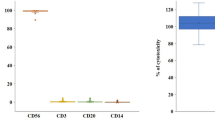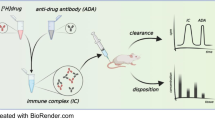Summary
In the preceding paper it was suggested that the tumour localisation of125I-labelled syngeneic rat monoclonal antibodies (mAbs) may be limited in immunocompetent hosts by the presence of competing endogenous serum antibodies. In syngeneic congenitally athymic (nu/nu) and cyclosporin-A-treated rats (both of which fail to mount immune responses to tumour antigens) increased uptake of mAbs in tumour tissue was obtained compared with that in immunocompetent animals. However, in the case of IgG2b and IgG1 mAbs, this appeared to be due primarily to enhanced “non-specific” localisation mediated by Fc binding, since it was abolished by the use of F(ab′)2 fragments with two out of three mAbs tested. Normal tissue distribution was also influenced by host immune status: in nu/nu rats the uptake of IgG2b mAbs in the spleen was up to fivefold higher than that previously found in normal animals and the levels in liver were also increased. This effect was not seen in cyclosporin-A-treated hosts, suggesting that the reticuloendothelial system of congenitally athymic animals contains cells with enhanced IgG2b-FcR activity. This hypothesis was strengthened by the observation that splenic uptake was reduced by either the use of F(ab′)2 fragments, or prior “blockade” of Fc receptors by “cold competition” with excess unlabelled IgG2b mAbs. This blockade could not be effected by mAbs of any other isotype or by IgG2b F(ab′)2 fragments. The former manoeuvre resulted in higher tumour specificity ratios but usually at the expense of reduced levels of tumour associated radiolabelled mAb. The latter was found to increase “absolute” tumour localisation by up to 35%. In an attempt to characterise further and compare the Fc receptor activity of intratumour and intrasplenic host cells. The distribution of IgG2b mAbs was assayed in 3-week, 8-week and 12-week-old rats. We were able operationally to distinguish the activity of these two categories of cells, suggesting that they represent either different lineages or differentially activated subpopulations: the splenic IgG2b binding was fully expressed in weanling nu/nu rats whereas the FcR activity of cells infiltrating MC24 sarcoma was limited in 3-week-old compared with 8–12-week-old hosts. A further difference was apparent in the subclass “preference” of FcR binding: in immunodeprived rats both IgG1 and IgG2b mAbs were able to bind to tumour-infiltrating host cells, but uptake of IgG1 mAbs in the spleen was always low and not reduced further by the use of F(ab′)2 fragments. These results demonstrate the extent to which the interactions between specific isotypes of rat mAbs and different subpopulations of host FcR-positive cells in both normal and malignant tissues may influence biodistribution patterns, particularly in athymic rodents. These interactions may occur to a greater or lesser extent across species barriers, and account should be taken of this in all studies designed to assay rodent mAbs for their potential usefulness in the diagnosis and treatment of human tumours.
Similar content being viewed by others
References
Buraggi GL, Callegaro L, Mariani G, Turvin A, Cascinelli N, Attili A, Bombardier E, Terno G, Plassic G, Dovis M, Mazzuca N, Natali P, Scasselati GA, Rosa U, Ferrone S (1985) Imaging with131I-labelled monoclonal antibodies to a high molecular weight melanoma-associated antigen in patients with melanoma: efficacy of whole immunoglobulin and its F(ab′)2 fragments. Cancer Res 45: 3378
Cheers C, Waller R (1975) Activated macrophages in congenitally athymic nude mice and in lethally-irradiated mice. J Immunol 115: 844
De Jong WH, Steerenberg PA, Ursem PS, Osterhaus A, Vos JG, Ruitenberg EJ (1980) The athymic nude rat. III. Natural cell-mediated cytotoxicity. Clin Immunol Immunopathol 17: 163
Denham S, Barfoot R, Jackson E (1987) A receptor for monomeric IgG2b on rat macrophages. Immunology 62: 69
Eccles SA, Styles JM, Hobbs SM, Dean CJ (1979) Metastasis in the nude rat associated with lack of immune response. Br J Cancer 40: 802
Eccles SA, Heckford SE, Alexander P (1980) Effect of cyclosporin A on the growth and spontaneous metastasis of syngeneic animal tumours. Br J Cancer 42: 252
Ezekowitz AB, Bampton M, Gordon S (1983) Macrophage activation selectively enhances expression of Fc receptors for IgG2a. J Exp Med 157: 807
Herberman RB, Nunn ME, Laurin DH (1975) Natural cytotoxic reactivity of mouse lymphoid cells against syngeneic and allogeneic tumours. 1. Distribution of reactivity and specificity. Int J Cancer 16: 216
Larson SM, Brown JP, Wright PW, Carrasquillo JA, Hellstrom H, Hellstrom KE (1983). Imaging of melanoma with I-131-labelled monoclonal antibodies. J Nucl Med 24: 123
Mann BD, Cohen M, Saxton R, Morton D, Benedict WF, Korn E, Spolter L, Graham L, Chang C, Burk M (1984) Imaging of human tumour xenografts in nude mice with radiolabelled monoclonal antibodies: limitations of specificity due to non-specific uptake of antibody. Cancer 54: 1318
Morgan AC, Foon KA (1986) Monoclonal antibody therapy of cancer: preclinical models and investigations in humans In: Herberman (ed) Cancer immunology: innovative approaches to therapy. Martinus Nijhoff, Netherlands
Murray JL, Rosenblum M, Sobol RE, Bartholomew R, Plager C,Haynie P, Jahns M, Glenn HJ, Lamki L, Benjamin R, Papadopoulos N, Boddie AW, Frinke JM, David G, Carlo D, Hersh E (1985) Radioimaging in malignant melanoma with111I-labelled monoclonal antibody 96.5. Cancer Res 45: 2376
Rosenblum MG, Murray JL, Haynie TP, Glenn HT, Jahns MF, Benjamin RS, Frinke JM, Carlo D, Hersh EM (1985) Pharmacokinetics of111In-labelled anti p-97 monoclonal antibody in patients with metastatic malignant melanoma. Cancer Res 45: 2382
Sands H, Shan SA, Jones PL, Neacy W, Gallagher BM (1985) Non-immunological factors affecting the localisation of monoclonal antibodies in xenografts of human breast and colon tumours. Dev Oncol 35: 303
Schlom J (1986) Basic principles and applications of monoclonal antibodies in the management of carcinomas. Cancer Res 46: 3225
Shah SA, Pollock R, Brown B, Gallaher BM, Scharff M, Sands H (1986) Pharmacokinetics and imaging using mutant monoclonal antibodies. Proc Am Assoc Cancer Res 27: 335
Sharp AK, Colston MT (1984) The regulation of macrophage activity in congenitally athymic mice. Eur J Immunol 14: 102
Wahl R, Wilson B, Leibert M, Beirwaltes W (1987) High dose, unlabelled non-specific antibody pretreatment: influence on specific antibody localisation to human melanoma xenografts. Cancer Immunol Immunother 24: 221
Author information
Authors and Affiliations
Rights and permissions
About this article
Cite this article
Eccles, S.A., Purvies, H.P., Styles, J.M. et al. Pharmacokinetic studies of radiolabelled rat monoclonal antibodies recognising syngeneic sarcoma antigens. Cancer Immunol Immunother 30, 13–20 (1989). https://doi.org/10.1007/BF01665025
Received:
Accepted:
Issue Date:
DOI: https://doi.org/10.1007/BF01665025




